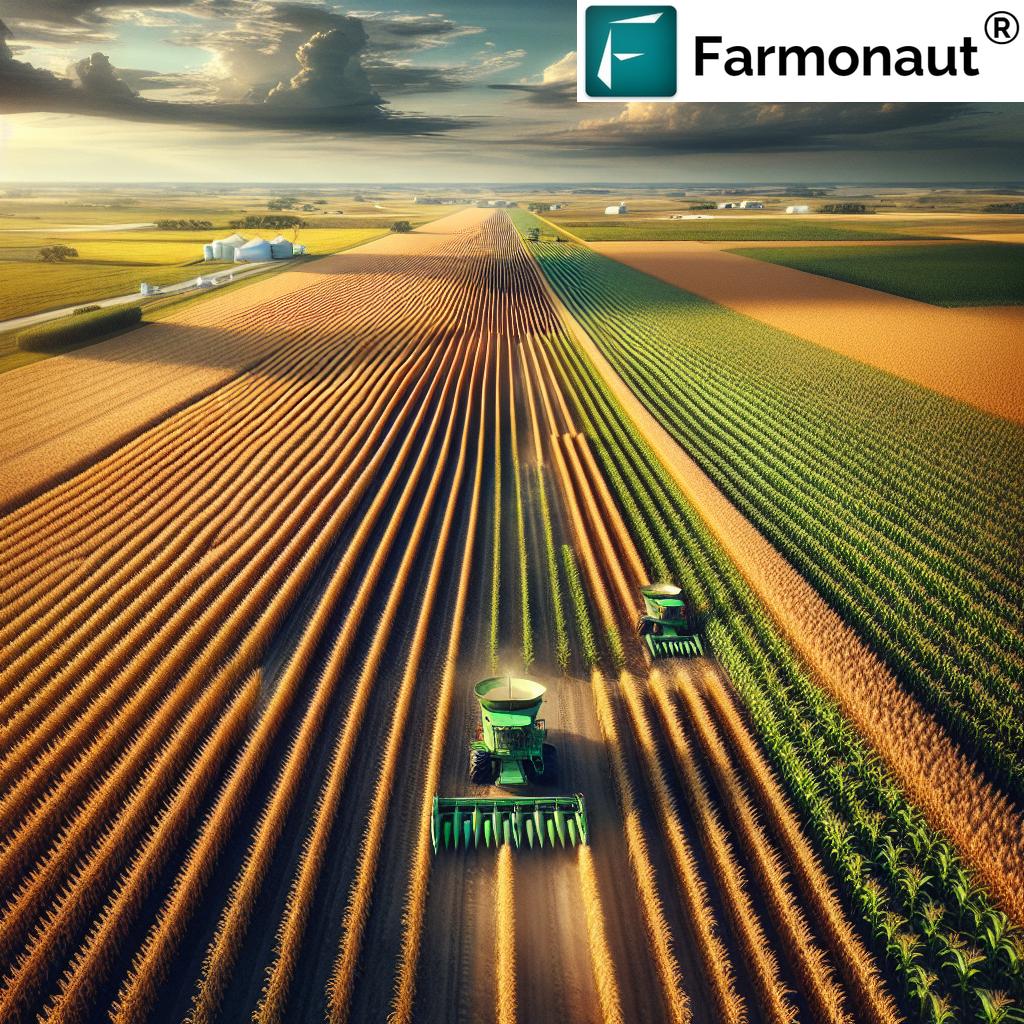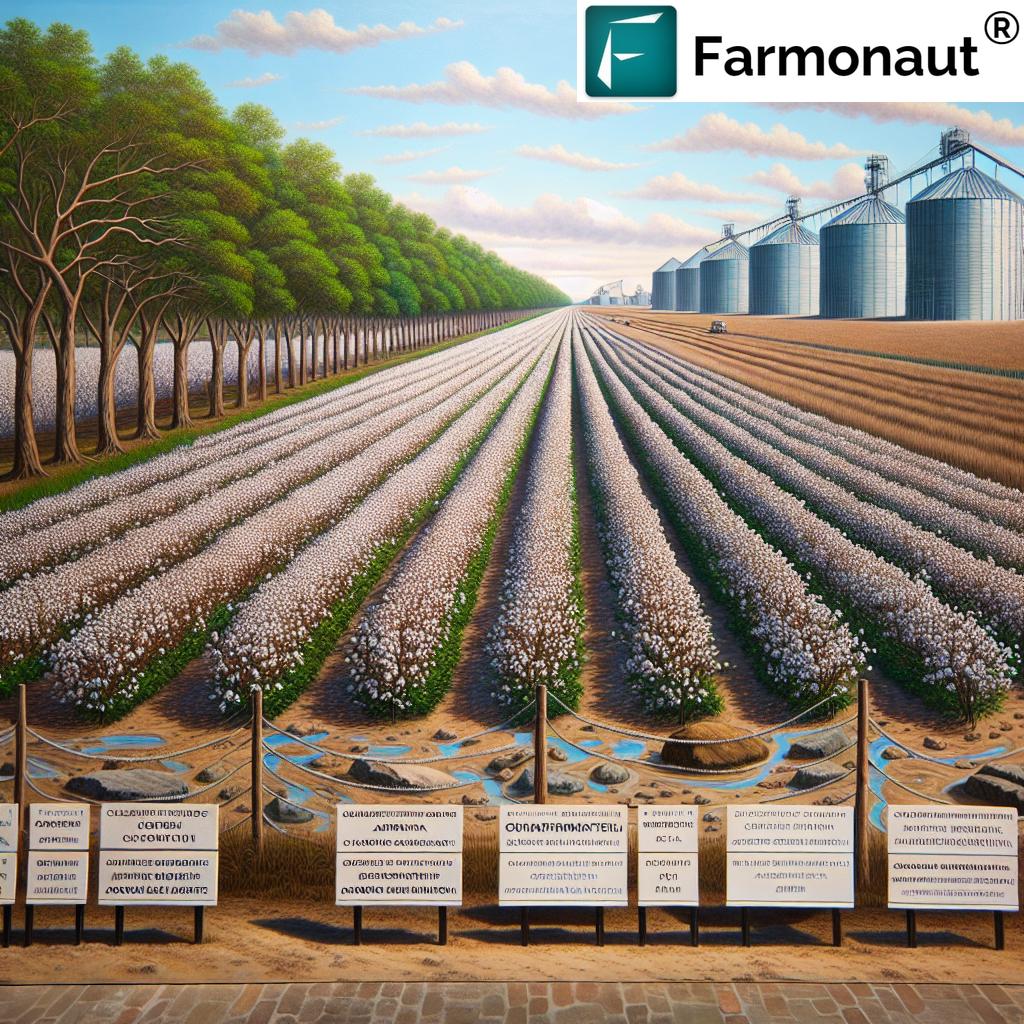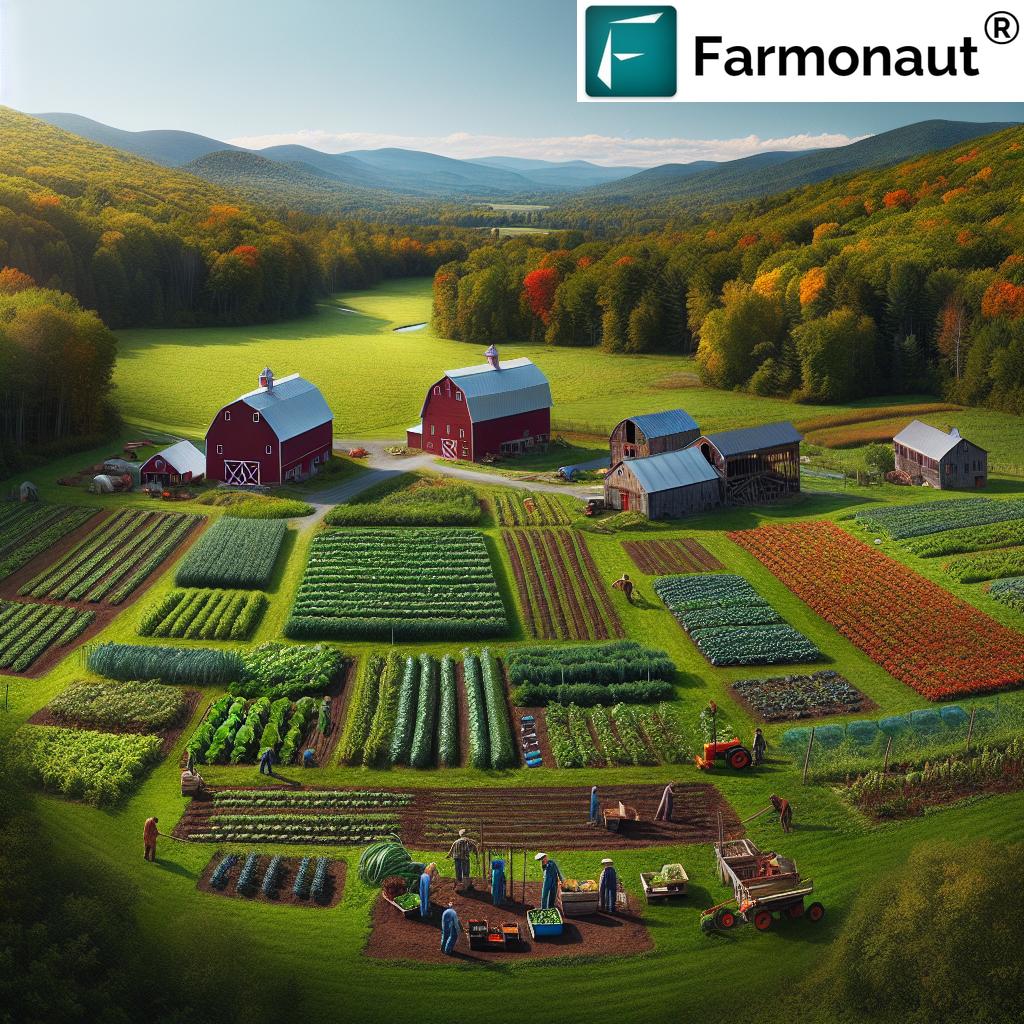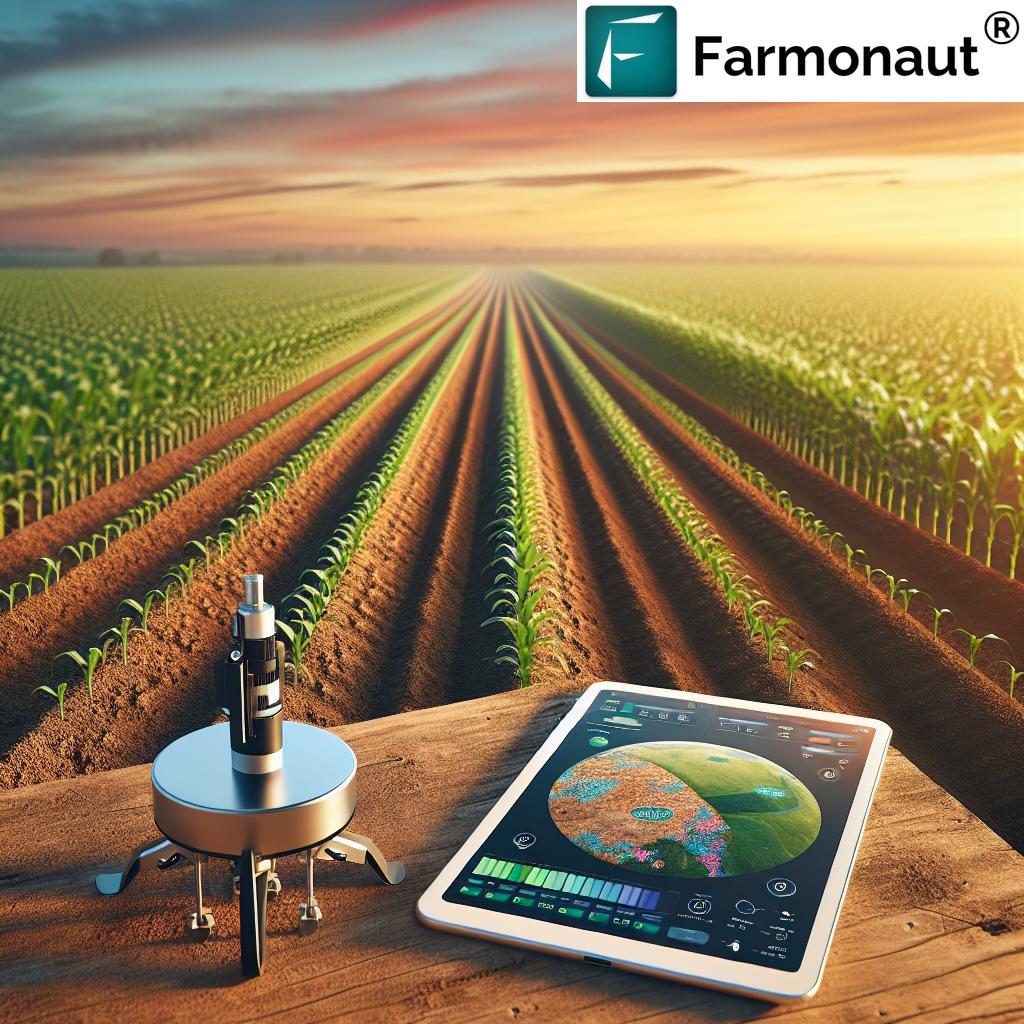Agriculture in the United States: 10 Shocking Innovations
“Over 60% of U.S. farms now use GPS-guided equipment, revolutionizing precision agriculture and crop management.”
Table of Contents
- Historical Overview: From Colonial Culture to Modern Farming
- Modern Agricultural Landscape and Regional Specializations
- Economic Impact of Agriculture & U.S. Farm Employment
- The Role of Technological Advancements in American Agriculture
- 10 Shocking Innovations Shaping Agriculture in the United States
- Comparison Table: Top 10 Innovations in U.S. Agriculture
- Environmental Challenges: Climate, Soil, and Sustainability
- Agricultural Policy, Trade Agreements & Future Outlook
- Farmonaut: Pioneering Precision Agriculture in America
- FAQ: Your Questions on U.S. Agriculture Answered
- Farmonaut Subscription Plans
- Conclusion: The Path Forward for U.S. Agriculture
Historical Overview: From Colonial Culture to Modern Farming
Agriculture in the United States has always been more than just the backbone of its economy—it’s deeply rooted in our culture, shaping both the physical and economic landscape of the nation. Our journey began in the colonial period, when European settlers first started cultivating staple crops like corn, wheat, and tobacco in the fertile soil of the Thirteen Colonies. The southern states, especially regions such as North Carolina, established expansive plantations that produced cash crops like tobacco, rice, cotton, and indigo, often relying on enslaved labor. The economic output of these early agricultural systems laid the groundwork for America’s rapid growth.
The 19th century marked a period of transformational change for American agriculture. The introduction of revolutionary technologies, such as John Deere’s steel plow and Cyrus McCormick’s mechanical reaper, mechanized farming and brought forth waves of productivity that have yet to cease. The rise of the Cotton Belt and Wheat Belt saw crops like cotton and wheat becoming central to U.S. crop production, especially in regions like Texas and the Great Plains. Over time, our farms transitioned from a patchwork of colonial plantations to a system of highly efficient, mechanized, and consolidated agricultural enterprises.
Modern Agricultural Landscape and Regional Specializations
Today, America’s agricultural sector is a testament to innovation, adaptability, and regional specialization. There are roughly 2.04 million farms spread across about 900 million acres—each farm averaging 441 acres. Our farms range from small family plots to massive industrial operations, with the latter contributing the lion’s share of the nation’s agricultural output. In fact, just 4% of farms with over $1 million in sales generate two-thirds of total output, illustrating how consolidation and scale shape modern farming in the U.S.
Key Agricultural Regions in the United States
- Midwest (Corn Belt): Iowa, Illinois, and Nebraska dominate in corn and soybean cultivation. The Corn Belt’s fertile lands are central to U.S. crop production and food industries.
- Great Plains (Wheat Belt): Regions like Kansas, Oklahoma, and Texas form the core of U.S. wheat production, with semi-arid climates suited for this vital crop.
- California’s Central Valley: As a powerhouse of fruit, vegetable, and nut production, Central Valley supplies a significant proportion of the nation’s produce and exports worldwide.
- Southern States: While historically known for cotton, tobacco, and rice, many southern states have diversified their agricultural output, integrating livestock, soybeans, and specialty crops.
Economic Impact of Agriculture & U.S. Farm Employment
The economic impact of agriculture is immense. Agriculture, food, and related industries contributed around $1.530 trillion to the United States GDP in 2023—about 5.6% of the total economy. Out of this, direct farm output contributed $203.5 billion, underscoring the pivotal role that farming and related services play in our country’s prosperity.
When we look at the labor force, it’s clear that agriculture supports an extensive network of industries and services. In 2022, approximately 22.1 million jobs, or 10.4% of total U.S. employment, were related to agriculture and food. However, direct on-farm labor accounted for only 2.6 million jobs (1.2% of the total). This distribution indicates the vast array of sectors—manufacturing, transportation, retail, logistics, and services—dependent on agricultural output and innovations.
The Role of Technological Advancements in American Agriculture
The story of agriculture in the United States is one of constant technological reinvention. From the mechanical reaper to today’s AI-driven solutions, we have continually embraced tools that enhance efficiency, productivity, and sustainability. Today’s modern farming techniques incorporate a blend of mechanization, biotechnology, and data-driven practices known as precision agriculture—each of which plays a pivotal role in maximizing yields and optimizing resource use.
- Mechanization: Tractors, combine harvesters, and automated irrigation systems have made intensive, large-scale farming possible.
- Biotechnology: Seed genetics and gene editing have produced crops with vastly improved yields, resistance to pests, and adaptability to changing climates.
- Precision Agriculture in America: GPS, satellite imaging, and data analytics allow farmers to manage field variability, optimize input application, and reduce waste, boosting sustainability and profitability.
The integration of these technologies into American farms marks a new era—one where data, automation, and sustainability are inextricably linked. From automated drones and soil moisture sensors to sophisticated farm management platforms, we’re experiencing an agricultural revolution that’s changing how we grow food, manage labor, and protect the environment.
“American farmers have increased corn yields by 500% since 1930, thanks to technological and genetic innovations.”
10 Shocking Innovations Shaping Agriculture in the United States
Nowhere else have technological innovations been as transformative as in modern American farming. Let’s dive into the top 10 innovations that have shocked, inspired, and propelled the agricultural sector into the future:
-
Precision Farming and Satellite Data
Satellite-based monitoring (as brought to the mainstream by platforms like Farmonaut) enables farmers to precisely monitor soil health, crop growth, and resource needs.
Benefits: Data-driven decisions increase yield, minimize costs, and help achieve sustainable farming practices.
Farmonaut offers Large Scale Farm Management, equipping operators to monitor vast plantations and react to real-time conditions using advanced satellite-generated reports. -
Biotechnology and Genetically Modified Crops
Biotech crops, especially corn and soybeans, dominate U.S. crop production. These genetically engineered crops are tailored for higher yields, pest resistance, and adaptation to variable climates.
Benefits: Biotech has increased productivity and security in the American food system. -
Autonomous Machinery (Robotics & Drones)
The rise of autonomous tractors, drone sprayers, and robotic harvesters is minimizing manual labor and maximizing efficiency across vast farmlands.
Benefits: Increased speed, precision, and uptake of labor-saving technology—especially crucial given the ongoing farm labor and employment challenges in the U.S. -
AI-Based Advisory Systems
Artificial Intelligence platforms like Farmonaut’s Jeevn AI Advisory System offer farmers real-time weather forecasts and custom crop management recommendations.
Benefits: Enhanced productivity and reduced risks due to better-informed farm management decisions. -
Blockchain-Based Product Traceability
Blockchain ensures transparent, secure tracking of farm products from field to consumer, reducing fraud and boosting trust.
Learn more about Farmonaut’s traceability platform for supply chain integrity and food safety. -
Resource Management Apps and Fleet Tracking
Digital fleet management and logistics optimization minimize costs and improve machinery usage on large farms.
Farmonaut provides dedicated fleet management tools to monitor, track, and optimize vehicles and equipment, reducing downtime and fuel consumption. -
Real-Time Carbon Footprinting
Advanced carbon monitoring tools help agribusinesses track and reduce their environmental impact, aligning with stricter sustainability goals and climate policies.
Farmonaut’s carbon footprinting solution provides up-to-the-minute emission tracking, supporting compliance and responsible agriculture. -
Automated Irrigation and Water Management
Smart irrigation systems leverage AI and sensor data to minimize water wastage and address water scarcity. These innovations are critical in arid regions like California’s Central Valley and Texas.
Benefits: Water savings and optimized irrigation cycles for better crop health, especially under climate change pressures. -
Controlled-Environment Agriculture (CEA)
Indoor vertical farming and hydroponics allow efficient food production in urban and climate-challenged environments.
Benefits: Reduced land needs, year-round production, and less water consumption. -
Digitized Crop Loan and Insurance Verification
Satellite-based verification tools reduce fraud in crop loans and insurances, while streamlining farmers’ access to finance.
Farmonaut’s crop loan & insurance module empowers banks and insurers with transparent, data-driven verification of farm activities and crop status.
Comparison Table: Top 10 Innovations in U.S. Agriculture
| Innovation Name | Year of Introduction (Estimated) | Brief Description | Estimated Impact on Yield/Efficiency | Adoption Rate (% of US Farms, Estimated) | Sustainability Benefits |
|---|---|---|---|---|---|
| Precision Farming & Satellite Data | 2010s | Real-time satellite and sensor data used for crop monitoring and decision-making. | +15-25% yield increase; input cost reductions | ~55–65% | Reduces resource waste, enables targeted interventions. |
| Biotechnology (GM Crops) | 1996 | Genetically engineered crops for higher yield & pest resistance (e.g., corn, soybeans). | +30–50% yield vs. traditional crops | ~85% (corn, soy); 94% (cotton) | Less pesticide use, more resilient crops. |
| Autonomous Machinery | 2020s | Driverless tractors, robotic planters, and drone sprayers. | Up to 20% labor reduction; 10–20% yield boost in test plots | 10–25% | Reduces fuel, labor, and chemical usage. |
| AI-Based Farm Advisory | 2020s | AI-driven, personalized recommendations for crops, irrigation, and pesticides. | 10–18% yield increase; lower risk | 20–35% | Minimizes chemicals, promotes best practices. |
| Blockchain Traceability | 2018 | Blockchain systems track produce from farm to fork transparently. | Improved food safety and reduced fraud | 5–10% | Encourages ethical practices, supports recall efficiency. |
| Resource Mgmt & Fleet Tracking | 2015 | Digital tools for optimizing farm vehicles and machinery operation. | Up to 20% cost savings, fewer breakdowns | 35–45% | Conserves fuel, extends equipment life. |
| Carbon Footprinting | 2021 | Real-time GHG emissions tracking for farms and agribusinesses. | Better climate compliance; up to 12% emission drop | 10–15% | Drives carbon reduction strategies, sustainability reporting. |
| Automated Irrigation | 2010s | Smart AI-powered irrigation adjusts water delivery by need and climate. | Water usage down 20–35% | 35–50% | Mitigates drought, preserves water resources. |
| Controlled-Environment Agriculture (CEA) | 2010s | Indoor vertical farming; hydroponics for year-round production. | 2–10x yield per acre (vertical systems) | ~5% | Land and water efficient, urban farming potential. |
| Satellite-Based Loan & Insurance Verification | 2021 | Satellite images verify farm area/yields for lenders and insurers. | Faster approvals, reduced claim fraud | 10–20% | Fair financing, widens farmer access to credit. |
Environmental Challenges: Climate Change, Soil Health, and Sustainability
Despite the impressive advances in agricultural technology, U.S. farming faces significant environmental obstacles:
- Climate Change and Agriculture: Unpredictable weather patterns, heatwaves, droughts, and floods threaten our crops and livestock health. Adaptive innovations and sustainable practices are necessary to mitigate these impacts.
- Soil Degradation: Continuous, intensive cultivation and monocropping lead to soil erosion and the loss of vital nutrients. Smart use of data and regenerative farming practices—like crop rotation and reduced tillage—help restore soil health and maintain long-term productivity.
- Water Scarcity: Efficient irrigation techniques and drought-tolerant crops are increasingly vital, especially in regions where water availability is under stress.
- Resource Management: Sustainability depends on optimizing every input, from fertilizer to energy. Precision agriculture and real-time data analytics are at the heart of sustainable agricultural output.
Farmonaut supports sustainability through carbon tracking, water usage analytics, and actionable recommendations for environmentally friendly farm management.
Agricultural Policy, Trade Agreements & Future Outlook
The direction of agricultural policy and trade agreements profoundly influences how we farm, what we grow, and how our food reaches global markets. The U.S. government operates a web of subsidies and policies designed to stabilize farm income, ensure food security, and maintain competitive market access.
- Subsidies & Support: These programs cushion farmers during market downturns or climate events, securing the backbone of our food supply.
- Trade Agreements: International trade is vital for the U.S. agricultural sector. Soy, corn, wheat, and other crops are key exports. Tariffs and trade deals can dramatically affect market accessibility and farm profitability.
- Research & Innovation: Investment in agricultural R&D has created waves of technological advancements, though recent funding cuts cause concern for continued adaptation amid changing climates and market demands.
For producers and agribusinesses, keeping pace with evolving policies, environmental standards, and technological shifts is a constant challenge—but also a critical opportunity to lead globally in food production, sustainability, and innovation.
Need seamless data-driven verification for compliance, subsidies, or insurance? Explore Farmonaut’s crop loan & insurance verification tools.
Farmonaut: Pioneering Precision Agriculture in America
Farmonaut is transforming modern farming techniques by integrating cutting-edge satellite imagery, artificial intelligence, blockchain, and machine learning into every stage of farm management. Our central aim at Farmonaut is to democratize access to precision agriculture in America—from individual farmers to large-scale agribusinesses, government officials, and financial institutions, everyone benefits from actionable, real-time insights.
-
Satellite-Based Crop Health Monitoring:
We offer cost-effective, high-frequency monitoring of vegetation health, soil moisture levels, and growth variability, using advanced multispectral imagery. Farmers can remotely analyze their fields, identify problem areas, and take timely actions to boost yields. -
Jeevn AI Advisory System:
This AI-powered farm advisory tool combines satellite data and machine learning to provide personalized, real-time advice—including weather forecasts and crop management strategies—enabling smarter farm decisions. -
Blockchain-Based Product Traceability:
Transparency in supply chains has never been more crucial. Our blockchain-powered traceability module keeps every transaction and handoff on record—from seed to supermarket—building trust and reducing the risk of fraud. Discover more about traceability for your agribusiness. -
Fleet and Resource Management:
Efficient fleet operation is now attainable for all farm sizes, thanks to automated scheduling, vehicle tracking, and usage optimization—cutting costs and promoting sustainable resource use. Learn more about our smart fleet management system. -
Carbon Footprinting & Sustainability:
With robust carbon emission analytics, Farmonaut helps users meet environmental regulations and supports the shift toward regenerative, climate-resilient agricultural practices. Get details on carbon footprinting for your operation.
Our platform is accessible as a web, Android, or iOS app, as well as via API for integration into business or governmental systems. Developers can explore our extensive data interfaces at Farmonaut API Developer Docs to create custom agricultural solutions or embed satellite weather data into their own platforms.
Whether you manage a single farm, a fleet of agricultural vehicles, a government subsidy program, or a global agribusiness, Farmonaut empowers you with the visibility, intelligence, and tools you need to thrive in the new era of American agriculture.
FAQ: Your Questions on U.S. Agriculture Answered
-
Q: What is the most significant technological innovation in agriculture in the United States?
A: Precision agriculture, powered by satellite and AI-driven insights, currently stands as the most transformative innovation. It allows for data-driven decisions in real time, optimizing every input and maximizing output. -
Q: How are policies and trade agreements affecting U.S. farm profitability?
A: Agricultural policy and trade agreements influence everything from crop subsidies to market access. Tariffs or favorable trade terms can mean the difference between profit and loss for farmers exporting crops like corn, wheat, and soybeans. -
Q: Are sustainable farming practices being widely adopted in the U.S.?
A: Yes. Practices such as reduced tillage, crop rotation, precision irrigation, and regenerative agriculture are increasingly incorporated, thanks to environmental concerns and the availability of advanced technology. -
Q: How do American farmers use satellite data in their daily operations?
A: Satellite data enables farmers to monitor crop health, track soil moisture, assess irrigation needs, and make informed decisions on fertilizer and pesticide usage. Platforms like Farmonaut bring affordable, actionable insights to farms of every size. -
Q: What are the key regions for farming in the U.S.?
A: The Midwest (Corn Belt) for corn and soybeans, the Great Plains for wheat, California’s Central Valley for fruits/vegetables/nuts, and the Southern states for cotton, rice, and diversified crops. -
Q: How is Farmonaut different from online marketplaces or input suppliers?
A: Farmonaut is a technology and data platform providing satellite-driven farm management, advisory, traceability, carbon footprinting, and fleet/resource management—not a marketplace, input supplier, or regulatory authority.
Farmonaut Subscription Plans
Ready to empower your farm, business, or organization with real-time, data-driven intelligence? Review our subscription options below:
Conclusion: The Path Forward for U.S. Agriculture
From colonial tobacco plantations of North Carolina and Texas to the sensor-filled fields of the modern Corn Belt, agriculture in the United States has been defined by our willingness to adapt, innovate, and lead. As we collectively address the challenges of climate change, labor shortages, water scarcity, and soil health, agricultural technology advancements like those showcased by Farmonaut will be essential for meeting economic, social, and environmental needs.
By embracing both time-tested sustainable farming practices and the very latest in AI, satellite imagery, and blockchain, we can build a more resilient, productive, and transparent food system. Whether you farm 5 acres or 5,000, opportunities abound—from boosting yield and securing supply chains to accessing new markets and financing options with satellite-based data and digital platforms.
The story of American farming is not just about crops and yields—it’s about the spirit of innovation, stewardship, and community. With the right tools and insights, the future of our agricultural sector is bright, sustainable, and full of promise.
If you’re ready to transform your farm or agribusiness, download Farmonaut today, or explore our suite of tools for carbon footprinting, traceability, fleet management, crop loans, and more. Join us on the journey to smarter, more sustainable agriculture!















